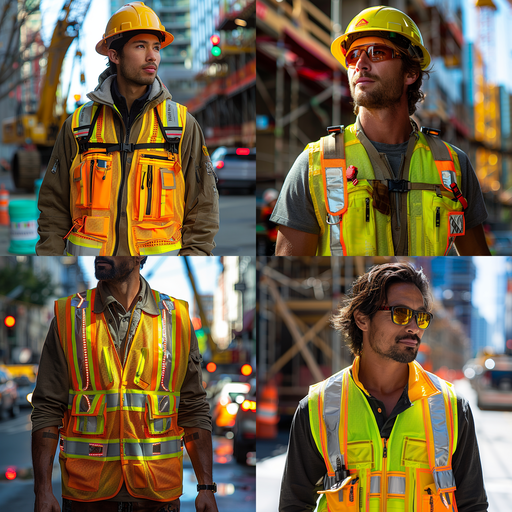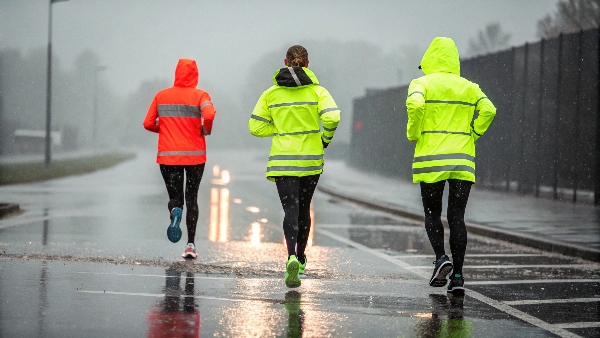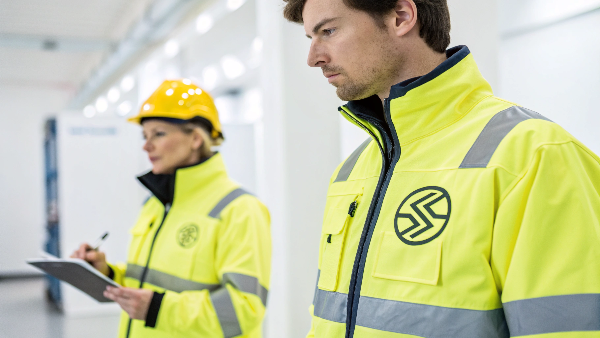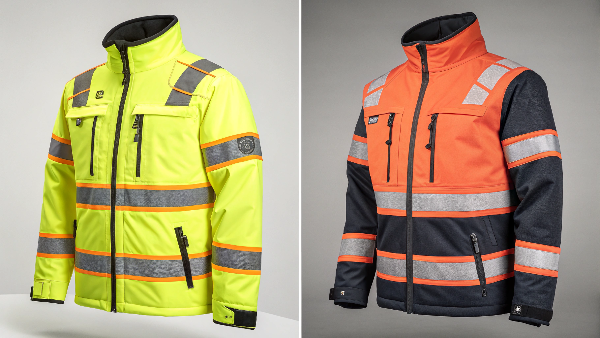
Workplace accidents are a big deal. They’re especially a big deal if you’re in a business where people can get hurt, like construction sites, warehouses, or if you have people working on the side of the road. You
want to keep your employees safe. If you don’t, people can get hurt or killed. You can lose a lot of money because of downtime and lawsuits. Let’s say a driver isn’t paying attention and runs over one of your
people. Or someone is driving a piece of equipment and doesn’t see someone in their blind spot. People can get hurt and killed, and your business will suffer. You’ll miss deadlines. You won’t ship products. You’ll
ruin your reputation.
High visibility clothing is a great way to keep people safe and prevent these things from happening. It’s a simple way to make sure people can see your employees, especially in low light or around moving vehicles. We sell high visibility clothing. It’s high quality, and you can customize it. It meets all the safety standards. Your people will be safe, and you’ll meet your
safety goals.
How High Visibility Clothing Can Support Your Company's Safety Goals
High visibility clothing is a critical safety measure that can significantly reduce the risk of accidents and injuries in the workplace, especially in hazardous environments like warehouses, construction sites, and roadside work zones. By making workers more easily seen by others, particularly those operating heavy machinery or vehicles, high vis apparel helps prevent collisions and other incidents that can lead to serious harm.
Here are some key ways high visibility clothing can support your company's safety goals:
- Increased Visibility
High vis clothing uses bright fluorescent colors and reflective materials to make workers stand out against their surroundings, even in low light conditions or inclement weather. This enhanced visibility is crucial for workers in areas with moving vehicles or equipment. - Accident Prevention
By making workers more noticeable, high vis apparel reduces the chances of being struck by a distracted or unaware driver or equipment operator. Fewer accidents mean fewer injuries and fatalities, which is the primary goal of any workplace safety program. - Compliance with Safety Standards
High visibility clothing is required by OSHA regulations for workers in certain industries and situations. Providing appropriate hi-vis apparel helps ensure your company meets these important safety standards and avoids costly fines or penalties. - Improved Morale and Productivity
When workers feel safe and protected on the job, it boosts morale and job satisfaction. This can lead to higher productivity, better employee retention, and a stronger safety culture overall. - Versatility and Comfort
High vis clothing is available in a variety of styles, from vests and jackets to shirts and pants, to suit different work environments and preferences. Choosing comfortable, durable options that allow for ease of movement is key for worker acceptance and consistent use.
To maximize the benefits of high visibility clothing, it's important to select garments that meet ANSI standards for your specific industry and work conditions. Providing training on proper use and care can also help ensure your high vis apparel remains effective over time.
By incorporating high visibility clothing into your company's safety program, you demonstrate a commitment to protecting your most valuable asset - your workers. This investment not only saves lives but also contributes to a more productive, engaged workforce and a stronger bottom line.
Keeping the Reader's Interest
As we've discussed, high visibility clothing plays a pivotal role in enhancing workplace safety. However, understanding the specific situations where such apparel is necessary and knowing the standards it must comply with are equally important. In the following sections, we will delve deeper into these aspects to provide a comprehensive guide on maximizing the benefits of high visibility clothing for your business.
When to Wear High-Visibility Safety Clothing
High-visibility safety clothing should be worn in situations where workers are at risk of being struck by moving vehicles or equipment due to poor lighting conditions or low visibility. Some key situations include:
- Low Light Conditions
Workers should wear high vis apparel when working in dimly lit areas, at night, or in inclement weather that reduces visibility. The bright fluorescent colors and reflective materials make workers stand out, even in the dark. - Around Moving Vehicles or Equipment
High visibility clothing is critical for workers in close proximity to moving cars, trucks, forklifts, backhoes, and other machinery. The enhanced contrast helps operators spot workers sooner and avoid collisions. - Federally Funded Highway Work
OSHA requires high vis clothing for workers on any construction, traffic control, or other job sites along federally funded highways. This is enforced under the Federal Highway Administration's worker visibility rule. - Manufacturing and Warehousing
While not always spelled out in regulations, OSHA can cite employers under the general duty clause for not providing high vis PPE in hazardous manufacturing and warehouse settings with moving equipment like forklifts. - Cycling and Motorcycling
Cyclists and motorcyclists may choose to wear high visibility vests, jackets, or other apparel to increase their conspicuity when riding among motor vehicles. Studies show it can reduce collision risk by over 50%.
To ensure compliance with ANSI/ISEA 107-2020 standards, high vis clothing should incorporate fluorescent background material, retroreflective trim, or a combination of both. The specific class required depends on the level of risk, with Class 3 providing the highest visibility for the most hazardous situations.
By making workers more noticeable, high visibility safety apparel is a critical safeguard for reducing struck-by accidents and injuries in a wide range of occupations and environments. Choosing the right garments for the conditions is key to maximizing their effectiveness.
What is the Standard Which High Visibility Clothing Must Comply With?
High visibility clothing must comply with the ANSI/ISEA 107-2020 standard, established by the American National Standards Institute (ANSI) and the International Safety Equipment Association (ISEA). This standard provides comprehensive guidelines for high-visibility safety apparel (HVSA), ensuring that garments enhance the visibility of workers in various environments, particularly where they may be at risk of being struck by moving vehicles or equipment.
Key Aspects of ANSI/ISEA 107-2020
- Performance Requirements: The standard specifies minimum performance criteria for the materials used in HVSA, including requirements for retroreflective and fluorescent materials to ensure visibility during the day and at night.
- Garment Types and Classes: The standard categorizes high visibility garments into different types (e.g., Type O for off-road use, Type R for roadway use, and Type P for public safety) and classes (Class 1, 2, and 3) based on the level of visibility required for specific work environments.
- Design and Construction: It outlines design requirements focusing on the placement and amount of high-visibility materials to provide 360-degree visibility, including specifications for the configuration and width of reflective bands.
- Testing and Certification: Garments must undergo rigorous third-party testing to be certified under the standard, ensuring they meet the specified visibility and performance criteria.
- Updates in 2020: The latest revision includes changes such as the removal of criteria for hi-vis accessories, updated definitions, and new testing requirements for segmented reflective materials to prevent manufacturers from overstating their effectiveness.
By adhering to the ANSI/ISEA 107-2020 standard, employers can ensure that their workers are equipped with appropriate high visibility clothing that enhances safety and compliance in hazardous work environments.
What is High Visibility PPE?
High visibility personal protective equipment (PPE) refers to specialized clothing designed to enhance the visibility of workers in environments where they may be at risk of being struck by moving vehicles or equipment. This type of apparel is crucial in various industries, including construction, transportation, and emergency services, where visibility is a significant safety concern.
Key Features of High Visibility PPE
- Fluorescent Colors: High visibility clothing typically incorporates bright fluorescent colors such as lime green, orange, or red. These colors are designed to stand out against most backgrounds, improving visibility during daylight hours.
- Reflective Materials: In addition to bright colors, high visibility PPE often includes reflective strips or materials that reflect light back to its source. This feature is particularly important for visibility in low-light conditions, such as during dawn, dusk, or nighttime.
- Compliance with Standards: High visibility clothing must meet specific safety standards, such as the ANSI/ISEA 107-2020 in the United States. This standard outlines the design, performance, and testing requirements for high visibility apparel, ensuring that it provides adequate protection and visibility in hazardous work environments.
- Types of Garments: High visibility PPE can include a range of garments, such as vests, jackets, coveralls, and pants. The choice of garment often depends on the specific work environment and the level of visibility required.
Situations for Use
High visibility PPE is essential in situations where workers are exposed to moving vehicles or equipment, particularly in:
- Construction Sites: Workers are often near heavy machinery and vehicles.
- Roadside Work: Flaggers and maintenance crews working close to traffic are required to wear high visibility clothing.
- Warehouse Operations: Employees working in areas with forklifts and other moving equipment benefit from increased visibility.
- Emergency Services: First responders often wear high visibility apparel to ensure they are seen by other motorists and personnel.
By enhancing worker visibility, high visibility PPE plays a crucial role in preventing accidents and injuries in various high-risk environments.
When Should High Visibility Clothing Be Replaced?
High visibility clothing should be replaced when it shows signs of wear that compromise its effectiveness in ensuring safety. Here are key indicators that indicate it's time for replacement:
Signs for Replacement
- Fading Fluorescent Color: If any part of the garment's fluorescent fabric has faded or become dull, it may no longer provide adequate visibility.
- Soiling: Garments that are heavily soiled or have stains that cannot be cleaned effectively should be replaced, as dirt can significantly reduce the reflective properties of the material.
- Physical Damage: Any tears, rips, holes, or worn spots can compromise the garment's integrity and visibility.
- Deterioration of Reflective Material: If the reflective bands or strips are damaged, worn, or fading, they may not reflect light effectively, reducing visibility.
- Visibility Testing: If the garment is no longer visible from a distance of 1,000 feet during the day or night, it should be replaced.
- Comfort Issues: If the garment is no longer comfortable to wear for extended periods, it may deter workers from using it, leading to safety risks.
- Regular Inspection: Conducting regular inspections using tools like a Garment Inspection Reference Card can help assess the condition of the fluorescent and reflective materials, guiding replacement decisions.
By monitoring these factors, companies can ensure that their high visibility clothing remains effective in enhancing worker safety and compliance with safety standards.
Is High Visibility Clothing Mandatory?
High visibility clothing is often mandatory in specific situations, particularly for workers exposed to hazardous environments where visibility is crucial for safety. Here are key points regarding the mandatory nature of high visibility clothing:
Situations Where High Visibility Clothing is Mandatory
- Construction and Road Work: The Occupational Safety and Health Administration (OSHA) mandates that workers on construction sites and those involved in traffic management on highways wear high visibility clothing. This requirement is enforced under the Federal Highway Administration's worker visibility rule, which applies to federally funded highway projects.
- Working Near Motorized Vehicles: OSHA requires high visibility apparel for employees working in proximity to moving vehicles, such as forklifts or trucks, especially in environments where visibility may be compromised due to low light or other factors.
- Emergency Responders: Law enforcement and emergency responders are also required to wear high visibility clothing during traffic control and cleanup operations following emergencies to ensure their visibility to motorists.
- Specific Job Roles: Certain job roles, such as flaggers, sanitation workers, and those involved in public safety activities, are often required to wear high visibility clothing as part of their safety protocols, especially when working in areas with traffic or heavy machinery.
General Guidelines
While high visibility clothing is not universally required for all workers, employers are encouraged to assess the risks associated with their specific work environments. In many cases, even if not mandated, wearing high visibility clothing can enhance safety and reduce the likelihood of accidents. Therefore, companies should develop clear policies regarding the use of high visibility apparel based on the nature of the work and potential hazards.
In summary, high visibility clothing is mandatory in specific high-risk situations, particularly where workers are exposed to traffic or moving machinery, and compliance with OSHA regulations is essential for ensuring workplace safety.
Conclusion
High visibility clothing is an indispensable component of a comprehensive workplace safety strategy. By enhancing worker visibility, it plays a crucial role in preventing accidents and injuries, particularly in hazardous environments. Compliance with standards like ANSI/ISEA 107-2020 ensures that the high visibility apparel used meets rigorous safety criteria, providing both protection and peace of mind.
Our range of high-quality, customizable high visibility clothing is designed to meet the diverse needs of various industries. Whether you're working in construction, warehousing, roadside maintenance, or emergency services, our garments offer the visibility, durability, and comfort necessary to keep your workforce safe and productive.
Investing in high visibility clothing is not just about meeting regulatory requirements; it's about demonstrating a commitment to your employees' well-being. By prioritizing safety, you not only protect your most valuable asset—your workforce—but also enhance morale, productivity, and ultimately, your bottom line.
For more information on how our high visibility clothing can support your company's safety goals, visit our website at vissafetywear.com or contact Ivy Xu at ivy@visafetywear.com. Together, we can create a safer, more productive work environment for your team.



